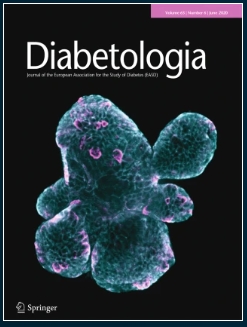Perceived blood glucose regulation after menopause: a cross-sectional survey in women with type 1 diabetes in the Netherlands.
IF 10.2
1区 医学
Q1 ENDOCRINOLOGY & METABOLISM
引用次数: 0
Abstract
AIMS/HYPOTHESIS Women with type 1 diabetes experience changes in insulin requirements in pregnancy and throughout the menstrual cycle. It remains to be explored whether women with type 1 diabetes perceive changes in glucose regulation during and after the menopausal transition, another period of marked hormonal change in a woman's life. METHODS We conducted a cross-sectional survey to investigate whether women with type 1 diabetes perceive changes in glucose regulation after their final menstrual period. The online questionnaires were distributed through advertisements in hospitals and through online platforms for people living with type 1 diabetes in the Netherlands. Postmenopausal women (≥1 year of amenorrhoea) with type 1 diabetes, aged 45-65 years, were included. Participants with primary amenorrhoea, premenopausal hysterectomy or a postmenopausal diabetes diagnosis were excluded from the study. The primary outcome was the extent to which participants perceived changes in their glucose regulation following their final menstrual period, assessed using a five-point Likert scale. Menopausal symptom severity was estimated using the Greene climacteric scale (GCS). RESULTS Questionnaires from a total of 159 women were eligible for inclusion. Participants had a mean age of 54.9 years (SD 3.8), a mean diabetes duration of 30.3 years (SD 12.8), and had their final menstrual period at a mean age of 50.1 years (SD 5.0). Overall, 67.4% of participants reported moderate to severe postmenopausal changes in glucose regulation. Increased blood glucose levels were perceived by 41.9% of participants, 19.6% perceived lower glucose levels and 38.5% perceived no change in blood glucose levels. For fluctuations in glucose levels, 55.0% experienced more fluctuations and 18.1% experienced less fluctuation. More hyperglycaemic events were experienced by 61.6% of participants, while 38.5% experienced more hypoglycaemic events and 28.0% experienced fewer hypoglycaemic events. Reported menopausal symptoms were more severe after the final menstrual period compared with before the final menstrual period (mean GCS score ± SD: 18.8±9.9 vs 11.7±8.3, p<0.001). An increase in postmenopausal symptom severity score was associated with an increase in the odds of perceiving postmenopausal changes in glucose regulation, with an adjusted OR of 1.04 (95% CI 1.01, 1.08; p=0.014). A total of 57.2% of participants had a global Pittsburgh sleep quality index (PSQI) score >5, indicating poor sleep quality. Poor sleep quality was not associated with perceived glycaemic changes after menopause (global PSQI >5) (adjusted OR 1.10; 95% CI 0.58, 2.08; p=0.731). CONCLUSIONS/INTERPRETATION Approximately two-thirds of women with type 1 diabetes perceive changes in their glucose regulation after menopause, including subjective changes in the number of hyperglycaemic and hypoglycaemic events. Changes in perceived glucose regulation were associated with the severity of reported menopausal symptoms. These results highlight the need for awareness among medical professionals treating women with type 1 diabetes, as those going through the menopausal transition may experience changes in glucose metabolism, which can affect their diabetes management. DATA AVAILABILITY The data that support the findings of this study are available on request from DataVerseNL with the identifier https://doi.org/10.34894/84QJOO .绝经后感知血糖调节:荷兰1型糖尿病女性的横断面调查。
目的/假设1型糖尿病女性在妊娠期和整个月经周期中胰岛素需求会发生变化。1型糖尿病女性在绝经过渡期(女性生命中另一个显著的激素变化时期)期间和之后是否感知到葡萄糖调节的变化仍有待探索。方法我们进行了一项横断面调查,以调查1型糖尿病女性在月经末期后是否感知到血糖调节的变化。在线问卷通过医院广告和在线平台向荷兰的1型糖尿病患者分发。绝经后妇女(≥1年闭经)合并1型糖尿病,年龄45-65岁。原发性闭经、绝经前子宫切除术或绝经后诊断为糖尿病的参与者被排除在研究之外。主要结果是参与者在最后一次月经后感知到的血糖调节变化的程度,使用五点李克特量表进行评估。使用格林更年期量表(GCS)评估更年期症状严重程度。结果共有159名女性的问卷符合纳入条件。参与者的平均年龄为54.9岁(SD 3.8),平均糖尿病病程为30.3年(SD 12.8),最后一次月经的平均年龄为50.1岁(SD 5.0)。总体而言,67.4%的参与者报告了中度至重度的绝经后血糖调节变化。41.9%的参与者认为血糖水平升高,19.6%的参与者认为血糖水平降低,38.5%的参与者认为血糖水平没有变化。对于葡萄糖水平的波动,55.0%的人波动更大,18.1%的人波动更小。61.6%的参与者经历了更多的高血糖事件,而38.5%的参与者经历了更多的低血糖事件,28.0%的参与者经历了更少的低血糖事件。经末期后报告的绝经症状较经末期前更严重(平均GCS评分±SD: 18.8±9.9 vs 11.7±8.3,p5,提示睡眠质量差。睡眠质量差与绝经后血糖变化无关(全球PSQI bbb50)(调整OR 1.10;95% ci 0.58, 2.08;p = 0.731)。结论/解释:大约三分之二的1型糖尿病女性患者认为绝经后血糖调节发生了变化,包括高血糖和低血糖事件数量的主观变化。感知血糖调节的变化与报告的更年期症状的严重程度有关。这些结果强调了治疗1型糖尿病女性的医疗专业人员需要意识到这一点,因为那些经历更年期过渡的女性可能会经历葡萄糖代谢的变化,这可能会影响她们的糖尿病管理。数据可用性支持本研究结果的数据可通过DataVerseNL的请求获得,其标识符为https://doi.org/10.34894/84QJOO。
本文章由计算机程序翻译,如有差异,请以英文原文为准。
求助全文
约1分钟内获得全文
求助全文
来源期刊

Diabetologia
医学-内分泌学与代谢
CiteScore
18.10
自引率
2.40%
发文量
193
审稿时长
1 months
期刊介绍:
Diabetologia, the authoritative journal dedicated to diabetes research, holds high visibility through society membership, libraries, and social media. As the official journal of the European Association for the Study of Diabetes, it is ranked in the top quartile of the 2019 JCR Impact Factors in the Endocrinology & Metabolism category. The journal boasts dedicated and expert editorial teams committed to supporting authors throughout the peer review process.
 求助内容:
求助内容: 应助结果提醒方式:
应助结果提醒方式:


